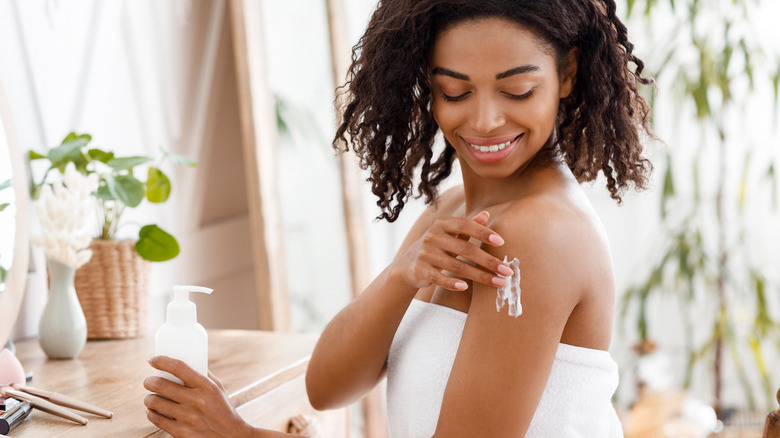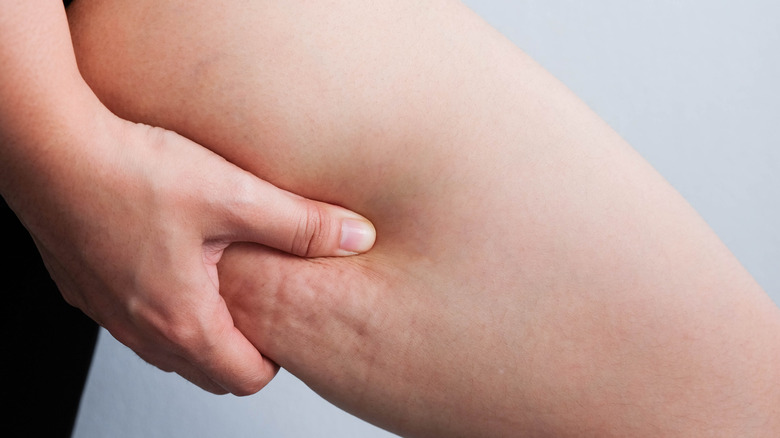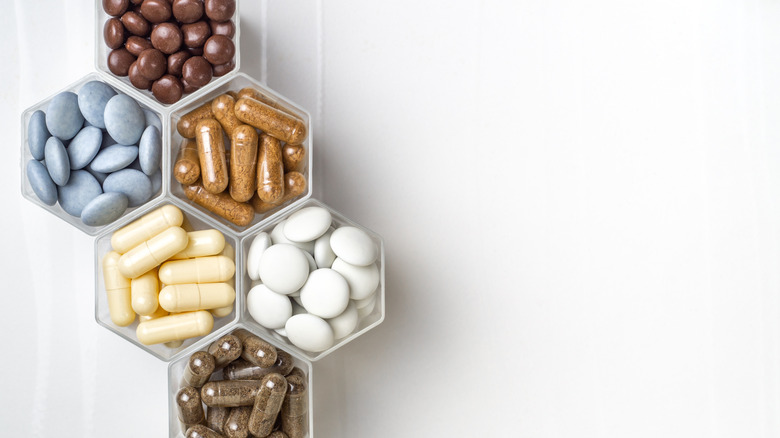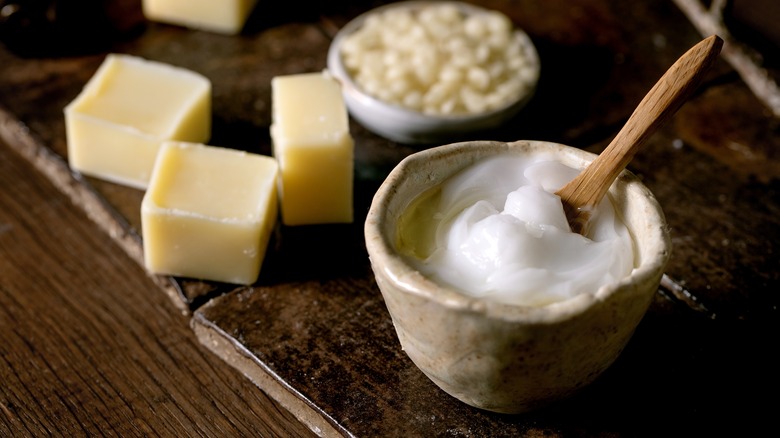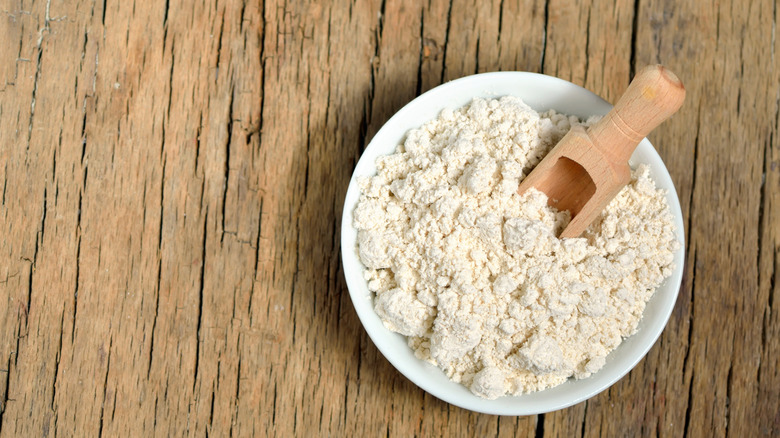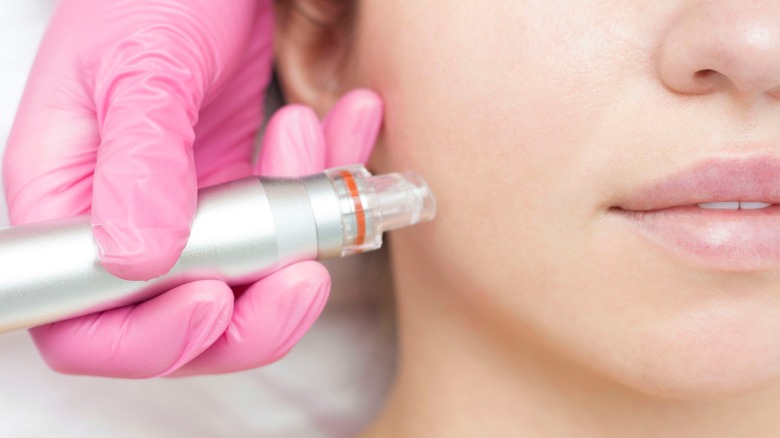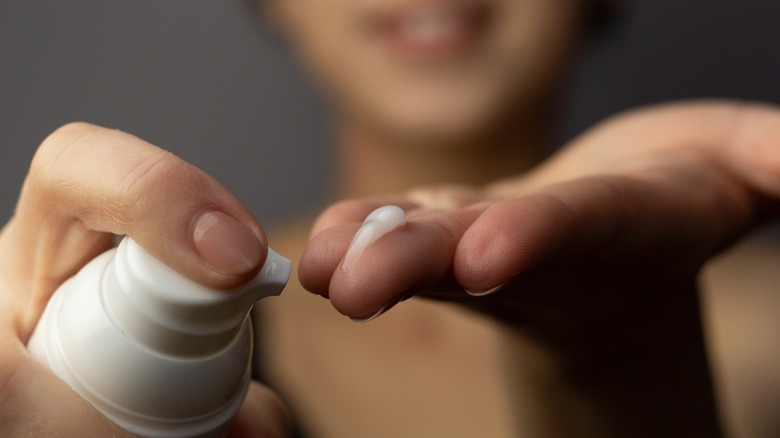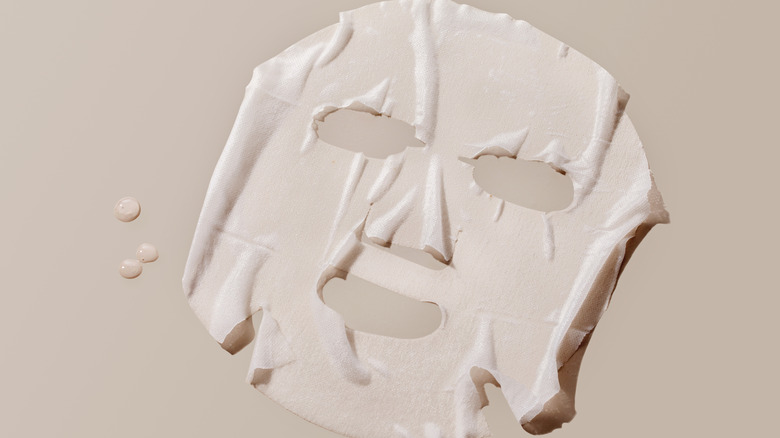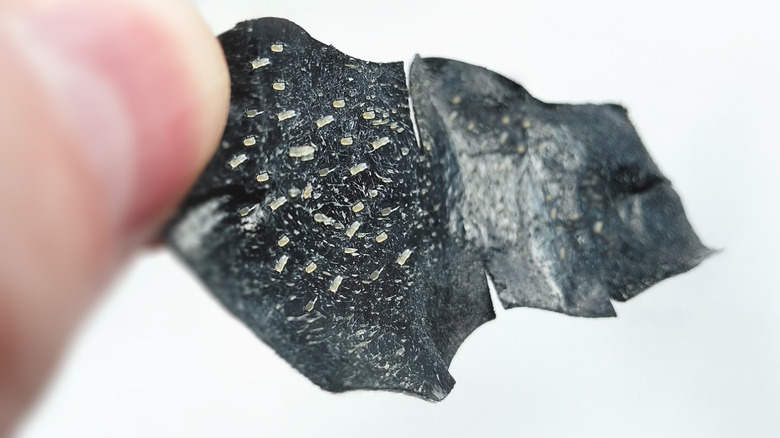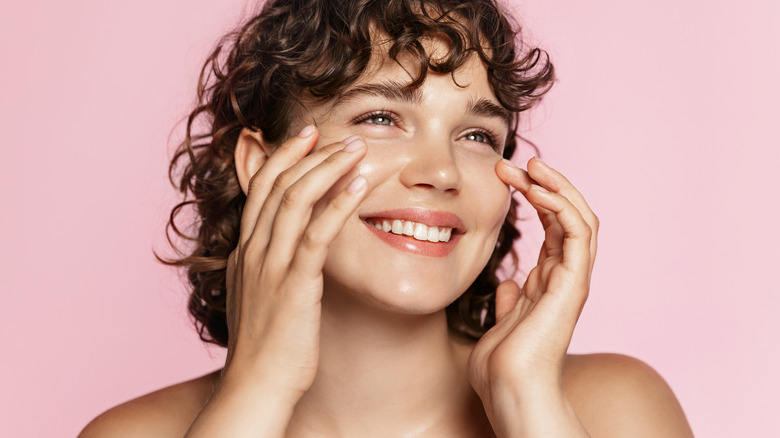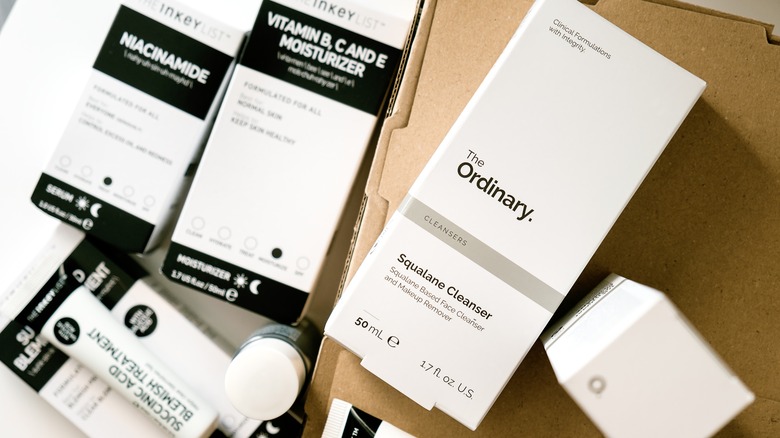Types Of Skincare Products That Aren't Worth The Hype
We may receive a commission on purchases made from links.
Sometimes, it's hard to resist the urge to buy whatever product or concoction is featured on your favorite creator's page. Unfortunately for the everyday consumer, though, PR isn't coming in the mail, so taking care when it comes to purchasing is important. Not every product is worth your money, so let's break down some of the alluring liquids and goos that you'd probably be better off without. After all, purchasing items that can help "self-improvement" is a known way to make oneself happier (via N26).
Whether it's an enticing DIY recipe, a trendy new ingredient, or a supremely potent product, most items need to stay far away from the online cart (depending on your budget). Focus on what you deem as essential to you — working backward from there — and consider the environmental impact of the product in question. Will you need it tomorrow, and is it super wasteful? The answers may help you determine which skincare products just aren't worth it.
Products that make big promises
Skincare products love to advertise proprietary ingredients and make grand claims of life-altering results, but beauty brands can't work literal magic. Cellulite creams, retinol alternatives, and untested brand-specific blends of lengthy ingredients can serve as a tricky temptation for that quick skin fix, but do they really work? "Cellulite is a complex biological process that no cream can currently correct," dermatologist David Bank told TheHealthy. It's so hard to resist a pleasantly marketed promise of smooth, cellulite-free skin, but one pricey cream isn't going to solve all your problems.
"The problem is under the skin in the dermis layer, and topical medications can not penetrate to that area to fix the issue," dermatologist Sarika Snell echoed to Insider. What's more, dermatologist Christine Choi Kim also told TheHealthy that, while retinol alternatives can improve collagen production and skin elasticity, nothing can truly match the results of a good old-fashioned retinoid. In skincare, the saying "too good to be true" is very serious.
Of course, if you read this and think, "My skin can't tolerate retinol. I need alternatives," don't freak out. Just be wary of those big promises. Dr. Mona Gohara told Marie Claire that despite the lack of research, many of her clients are opting for more natural options. Dr. Gohara appreciates some consumers' wishes for non-chemical formulas, but she always comes back to retinol for its unique ability to increase collagen in the skin. Green products can make a difference when it comes to wrinkles, so they're not a total scam, but keep that in mind when making these kinds of purchases.
Unsubstantiated supplements
Beauty supplements always seem to offer love, riches, and baby-butt skin, but you can't really trust the label unless it's been third-party tested. A skin-enhancing pill might be worth your money, but only if it comes with evidence to support it. A science-backed article from Skin Therapy Letter in 2019 mentions that while some supplements can absolutely yield positive results, there just isn't a lot of evidence upholding many of the options on the market. And without that scaffolding, it's hard to tell where to place the weight of your wallet. In 1994, the Dietary Supplement Health and Education Act (DSHEA) changed the U.S. Food and Drug Administration's classification of dietary supplements. All of a sudden they were (and still are) considered foods, meaning companies aren't legally obligated to substantiate efficacy, safety, or quality. So, basically, we're on our own here. Brands can release these supplements to the public without conducting research on whether or not their products' ingredients interact with each other.
If you're in the market for a clinically-proven supplement to add to your skin and self-care regimen, make sure to look for one that has been third-party tested. This means that another company has evaluated the ingredients and safety of the product in question, and each verification comes with its own stamp approval hidden somewhere on the container. Consumer Reports recommends adhering to ConsumerLab.com, NSF International, and U.S. Pharmacopeia (USP).
Elaborate DIY recipes
DIY skincare recipes can often be just as costly as, if not more expensive than, a product formulated for your specific skin concerns, and they typically only last for a single use. Not only is a raw banana a lumpy mess, but by the time you squish it up with turmeric, honey, lemons, and coffee grounds, you might be wondering if you're actually making your life easier. Now, if you have the ingredients already and want to try a recipe, give it a go, but going out and buying everything all at once is probably a waste of your money.
DIY skincare can even be dangerous. It sounds so dramatic, but certain ingredients and techniques can be damaging to your skin barrier and cause breakouts. Yale School of Medicine dermatologist Mona Gohara told Insider that irregular, non-water soluble particles like coffee grounds may cause microabrasions when dabbling with an at-home exfoliating mask, which is especially harmful to sensitive skin, according to Arsenault Dermatology. What's more, combining things without understanding how they work in tandem opens you up to all sorts of lasting changes.
"The problem is when people try to make their own masks or products without fully understanding how they work together," aesthetician Haley Kulow told Dermstore. "This can result in a big mess with no major changes to your skin." Products are formulated by cosmetic chemists to remain stable and deliver the proper amount of each ingredient; DIY skincare is not.
Simple DIY skincare can be expensive, too
Elaborate recipes aren't worth the money because the individual ingredient cost adds up, they're often not properly formulated, and they offer a single use, but simple DIY skincare hacks can fall into these categories, too. For example, raw eggs are a common homemade suggestion for treating discoloration and elasticity, but even though eggs are affordable, you won't appreciate the cost of facial repairs (via Dermstore). Thomas mentions that this tactic can cause severe breakouts and even scabbing. "You can save a lot more money in the long run by just having one to two professional skincare treatments to address your concerns rather than 10 or more treatments to correct the damage done by what you did at home," aesthetician Breanna Thomas explained to Dermstore. Eggs are a bargain for breakfast but are often a liability over the bathroom sink.
Not all DIY methods are evil, but research is important. It's not worth your money to do a whole grocery run just for your face, but Lab Muffin Beauty Science swears by oatmeal. In fact, you can use a simple combination of oats and water to treat everything from inflammation to eczema. It's "one of those rare traditional remedies," Lab Muffin Beauty Science explains — rare in the sense that you might've heard about it from your grandma and that it's scientist-approved. Just grind up some oats, soak them in water, and pat the cereal milk-esque liquid onto your skin before rinsing and repeating as many times as you'd like.
Anything that should be done by a professional
Treatments are a heavy-duty way to slough off dead skin cells and walk away glowing. Today, there are plenty of at-home kits readily available for things like microneedling and chemical peels, but just because you can doesn't mean you should. There are some dangers to be aware of before you decide whether or not these makeshift professional products are worth your time, money, and energy. You don't want to overdo it trying to save on a spa day, only to then spend months on treatments and appointments in order to correct an at-home mistake.
Certain types of treatments, like intense chemical peels and some laser procedures, should be left solely in the hands of board-certified cosmetic surgeons, says the American Board of Cosmetic Surgery's Skin Resurfacing Guide. Microneedling, gentler peel options, and microdermabrasion can all be safely administered by a certified nurse or aesthetician, but most of us don't hold one of these titles.
"Without proper training, one can very easily burn themselves and even create scars," board-certified dermatologist Dr. Peterson Pierre explained to Real Simple about personal chemical peel kits. If you're going to try it, he recommends caution, a trial run, and milder acids, such as lactic and mandelic acids. Otherwise, you risk burning your money as well as your face. Another popular bathroom medical product is the microneedling kit. On this, Melanie D. Palm, M.D., told Real Simple that this type of procedure actually punctures the skin in order to promote collagen production and that it requires the use of a topical anesthetic. If your device penetrates too deep at home, you won't have that prescription readily available. Also, unless your bathroom is as clean as a doctor's office, you're putting yourself at risk of infection. Thus, it's best to save your money.
Unnecessary actives
A maximalist skincare routine can be luxurious and relaxing, but for anyone on a budget, more isn't always more. If you can't pinpoint an obvious reason for using it, or you're only applying it as a force of habit, that's a good indicator of excess (via Insider). Dermatology consultant Dr. Emma Wedgeworth suggested to HuffPost that adding more than five or six steps to your routine is time-consuming and not likely to do you any favors. So, for example, if you're not struggling with acne or clogged pores, you don't need to be applying salicylic acid every day. Focus on what your skin needs. Plus, here's a tip: purchase the mini size of a product and do spot treatments to save money and make it last longer.
It's important for both your wallet and skin health to eliminate unnecessary products. On this, dermatologist Dr. Jeanette Graf told Insider, "Too much of a good thing can result in redness, irritation, dryness, and worsened breakouts." There are so many delightfully smooth, slippery, and glowing options to choose from that it's alarmingly easy to overwhelm your skin. They can have adverse effects and completely disrupt the skin barrier, which may take weeks to repair as the cell turnover cycle lasts about 28 days (via Medifine Skin Clinic). "If we are using too many actives, this can cause skin barrier function disruption which can lead to acne spots, perioral dermatitis, eczema and exacerbated rosacea symptoms," clinical aesthetician Pamela Marshall explained to HuffPost.
Sheet masks are a single-use serum
While they're undoubtedly relaxing and allow every morsel of serum to soak into the skin, sheet masks are a one-and-done item. That means both environmental consequences and a high price per ounce. For example, the Wishful Thirst Trap Rose & Aloe Vera Soothing Sheet Mask is $9 at Sephora. It's a hydrating product with aloe vera, sodium hyaluronate, and niacinamide, which sounds great, but you have to spend another $9 to use it again. And you'll want to buy even more in order to see any real results.
Skincare consistency and product repetition are important. It takes time to see lasting improvements, and in that amount of time, think about how many masks you'll have thrown away. Susan Stevens, the founder and CEO of Made With Respect, an environmental collective focused on sustainability-conscious brands, is explained to Elle that face masks do more harm than good because of the trash they create. The whole thing gets thrown away, and every bit of synthetic material breaks down into various forms of pollution.
As an alternative to single-use sheet masks, try a reusable version. Just soak it in your favorite serum and experience all of the at-home spa joy for a much more sustainable price. For instance, Honest Beauty offers its Reusable Magic Silicone Sheet Mask for $15. Just pop it on after your existing routine to enhance the absorption of every treatment, cream, and oil.
Pore strips are satisfying, but they're not worth it
It's intoxicating to watch those little sebaceous filament worms wiggle out of your nose pores, but this solution isn't permanent. Pore strips are a potentially irritating — and environmentally unfriendly — product that truly isn't worth the money. In fact, Board-certified dermatologist Marisa Garshick explained to Real Simple, "Many [pore strips] can help temporarily improve the appearance of blackheads, but they are not designed to prevent breakouts or keep blackheads from forming." It's an instant gratification type of experience, not one to rely on for tangible improvements.
They can also cause severe irritation depending on your skin type and the other products in your routine, explains Azadeh Shirazi, M.D. (via Real Simple). While they may have positive temporary effects, pore strips contain adhesives that may be too harsh for certain customers. Other hefty exfoliants like Retin-A have been known to cause a reaction when used alongside pore strips.
AHA and BHA chemical exfoliators will do more work for you than the physical (and wasteful) method, and you'll be able to leave the house afterward without a beet-red face. Chemical exfoliants work to accelerate cell turnover by breaking down the bonds adhering to skin cells to each other, leaving you with fresh skin. "As those bonds are broken, the top layers of the skin cells shed, revealing regenerated skin," Dr. Michelle Lee, a board-certified plastic surgeon, told Healthline. It sounds kind of grotesque, but this type of beneath-the-skin exfoliation receives high praises from the skincare community and definitely deserves your dollar more than the pore strips of your middle school years.
Products you won't use consistently
Consistency is vital when it comes to seeing lasting skincare benefits. "One of the biggest skincare mistakes is an inconsistent skincare routine — switching your regimen around and jumping from one product to another," Dr. Macrene Alexiades told our sister site The List. It takes time for a product to work. We've been talking a lot about cell turnover, the consensus being 28 days. What's more, Curology founder David Lortscher, M.D., explained to Well + Good, "Cell turnover is the continuous process of shedding dead skin cells and subsequently replacing them with younger cells."
This process happens naturally, but with the help of a good, well-balanced routine, you can speed up the cycle and walk around with brighter, plump-looking skin. Of course, you shouldn't buy every shiny new product that catches your eye. It's an expensive habit that makes it impossible to tell which serums and masks are actually helping (or hurting) your skin. Switching it up too often or buying things that you won't use consistently wastes your money and confuses your face.
Dermatologist Melanie Palm corroborates the 28-day turnover cycle, and that's only for the top layer (via Well + Good). It takes another three or four rounds to overhaul deeper layers and observe whether or not a product is affecting change within your skin. "It usually takes three to four months to evaluate whether a skincare change is working to improve the overall appearance of the skin," Palm adds. That's a bit of an extreme length of time but also something to keep in mind when thinking about ditching a product early due to a lack of results. Don't buy a hasty replacement. Stick with what you have, at least for those first 28 days.
Pricey basic formulas
This last one is easy. When The Ordinary, The Inkey List, and Good Molecules exist, there's no reason to be shelling out hundreds for a hyaluronic acid. Simple formulas have no business costing as much as several utility bills. Dr. Barbara Sturm's $300 hyaluronic acid serum is honestly hard to look at. Like, why does that exist? The Ordinary offers its Hyaluronic Acid 2% + B5 Hydrating Serum for $7.50, and get this: it's still hyaluronic acid.
Insider asked dermatologists about skincare money wasters, and New York-based dermatologist Susan Bard agreed that expensive staples and basics are just not worth the splurge. "When it comes to these items, you can find some wonderful products at the drug store," Bard explained. She recommends saving those expensive skincare purchases for products with high-end, high-powered ingredients, mentioning growth factors and peptides as worthy examples. Don't opt for luxury when your local drug store or the affordable section at Ulta Beauty will deliver the same dependable quality.
